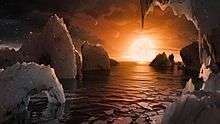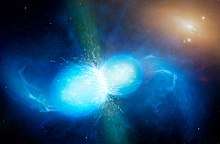Saraswati Supercluster
The Saraswati Supercluster is a massive galaxy supercluster about 1.2 gigaparsecs (4,000 million light years) away within the Stripe 82 region of SDSS, in the direction of the constellation Pisces.[1][2] It is one of the largest structures found in the universe, with a major axis in diameter of about 200 Mpc (652 million light years). It consists of at least 43 galaxy clusters, and has the mass of 2 × 1016 M☉, forming a galaxy filament.[3]
| Saraswati Supercluster | |
|---|---|
| Observation data (Epoch J2000.0) | |
| Constellation(s) | Pisces |
| Right ascension | 23h 37m 40s |
| Declination | 00° 16′ 17″ |
| Number of galaxies | 43 |
| Major axis | 200 Mpc (652 Mly) |
| Redshift | 0.28 |
| Distance (co-moving) | 1.2 Gpc (4 Gly) |
| Binding mass | 2.0×1016 M☉ |
Discovery
The Saraswati supercluster was discovered by a team of astrophysicists from the Inter-University Centre for Astronomy and Astrophysics and Indian Institute of Science Education and Research led by J. Bagchi and colleagues in Pune, India. Analyzing the data of Stripe 82 of the comprehensive Sloan Digital Sky Survey, particularly the sets of LOWZ data from the Baryon Oscillation Spectroscopic Survey, part of the DR12 catalogue of the SDSS, the team discovered an overdensity of the sampled 625 galaxies from LOWZ and 3,016 from the LEGACY-BOSS-SOUTHERN, a survey of the southern sky that is also a part of SDSS DR12. It was discovered in 2017.[1]
Cosmology
The Saraswati Supercluster is one of the largest and most massive superclusters known, comparable to the massive Shapley Concentration in the nearby universe. The supercluster consists of 43 massive galaxy clusters, which include Abell 2361 and ZWCl 2341.1+0000. It is surrounded by a network of galaxy filaments, clusters, and voids.
The Saraswati supercluster and its environs reveal that some extreme large-scale, prominent matter density enhancements had formed in the past when dark energy had just started to dominate structure formation. This galactic concentration sheds light on the role of dark energy and cosmological initial conditions in supercluster formation.[4][5]
References
- Bagchi, Joydeep; Sankhyayan, Shishir; Sarkar, Prakash; Raychaudhury, Somak; Jacob, Joe; Dabhade, Pratik (2017). "Saraswati: An Extremely Massive ~ 200 Megaparsec Scale Supercluster". The Astrophysical Journal. 844: 25. arXiv:1707.03082. Bibcode:2017ApJ...844...25B. doi:10.3847/1538-4357/aa7949.
- "Descubierta Sarasvati, una de las mayores estructuras del universo" (in Spanish). El País. 14 July 2017. Retrieved 14 July 2017.
- ""Saraswati"- one of the most massive large-scale structures in the Universe discovered". IUCAA. Archived from the original on 29 July 2017. Retrieved 14 July 2017.
- Crane, Leah (14 July 2017). "Galaxy supercluster is one of the biggest things in the universe". NewScientist. Archived from the original on 8 October 2017. Retrieved 12 January 2018.
- "'Saraswati': A Supercluster Of Galaxies Discovered By Indian Scientists". HuffingtonPost. 14 July 2017. Archived from the original on 14 July 2017. Retrieved 12 January 2018.


